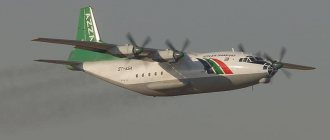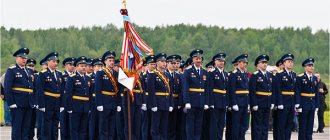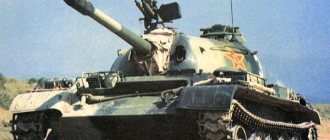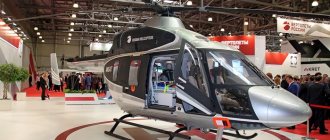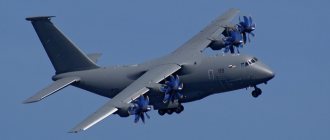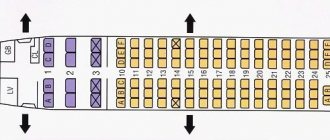The An-32 is a light multi-purpose military transport aircraft that can be operated in a variety of climatic conditions, including hot climates (up to 50° C), as well as at high-mountain airfields (altitude up to 4500 m). The main purpose of the An-32 is to transport cargo on medium- and short-distance lines. In addition, it can be used to transport parachute landings of military personnel, military platforms with cargo, including as part of the actions of the Ministry of Emergency Situations or a sanitary version for military personnel. The An-32 has high maneuverability during flights to mountain airfields with difficult approaches.
Story
The An-32 is the only aircraft in the entire history of Soviet aviation that was created specifically for export and was not adopted into service in the USSR.
The Indians realized the need to use military transport aircraft to supply high-mountain strongholds. The prerequisite for this was the results of the debilitating Indo-Pakistani conflicts and the deterioration of relations with China in the early seventies.
Initially, the Indian Air Force tried to use the American Lockheed C-130 Hercules, they flew it over several high-altitude areas, but it turned out that in the thin air of the C-130, the pilots could not cope with the leveling of the vessel, the landings were very hard, and there were some incidents, including an accident with landing gear failure. At the same time, in similar conditions, no such problems arose with the An-12, but due to its large size it was not very suitable for high-mountain sites with difficult approaches.
In any case, Delhi decided to cooperate with the Antonov Design Bureau, it was about the supply of 150 aircraft
Antonov himself suggested that the Indians pay attention to the already existing An-26. They took a closer look and found a number of advantages in it, but customers did not see the opportunity to work from high-altitude airfields due to the lack of engine power.
The requirements for the aircraft were extremely stringent: the aircraft had to be able to fly in the most inaccessible high mountain areas on the border with China and Pakistan, have a high thrust-to-weight ratio and high maneuverability on unequipped airfields. The main potential goal was to reach a ceiling of 6000 m with one running engine. At that time, no aircraft in the world had such capabilities.
For the designers, the initial task was to equip the An-26 with more powerful engines; a power plant from the An-12 was used, and AI-20M engines with a power of 4250 e were installed. l. With. and AB-62I propellers with a diameter of 4.5 m, which made it possible to increase power by 50%. In this case, it was necessary to install the engines above the wing and provide clearances, since the increased size of the propellers did not have enough space for rotation, the blades touched the fuselage. The power plant control devices were replaced, and wheels with brakes of increased energy capacity were installed. Due to the increased required landing speed, the pressure in the brake system was increased from 90 to 120 atmospheres. The designers replaced the RU19A-300 auxiliary engine with a more compact TG-16 turbogenerator, capable of starting engines at airfields up to 4500 m high. The initial work was completed in the same 1975. At that time, in the USSR the plane was already nicknamed An-32.
In the mid-1990s, production of the An-32 was discontinued. After a ten-year break, at the beginning of 2005, Kiev resumed production of aircraft (the first was the An-32P firefighter for Libya). In August 2009, Iraq ordered six more An-32s (they were delivered in 2011-2012).
As of 2015, the estimated cost of one modernized An-32 aircraft was $15 million.
Links[edit]
- Karnozov, Vovick. "Updated An-32 on flight tests." AeroWorldNet,
October 16, 2000. Archived May 21, 2007, at the Wayback Machine. - ^ ab "registry of aircraft of the Antonov An-32 type". russianplanes.net
. Archived from the original on 2015-09-10. - ^ abc Allport, Dave (April 1996). "Handbook of military transport aircraft (Part 2)." Air International
. Vol. 50 pcs. 4. paragraph 239. - ^ abc Antonov An-32. “But no, An is. Ukraine "found" lost Indian An-32s." https://warfiles.ru/,
[
permanent dead link
] April 20, 2015 - ^ a b "An-32". Archived September 6, 2005 at the Wayback Machine Antonov.com.
Access date: November 12, 2011. - ^ ab "Kiev aviation An-32B - 110/120". Archived August 8, 2008
on the Wayback Machine
aviant.ua.
Access date: November 12, 2011. - "Kiev Aviation - An-32B-300." Archived February 20, 2009
at the Wayback Machine
aviant.ua.
Access date: November 12, 2011. - "AKL-201603 AviaKollektsia 3 2016: Antonov An-32 Cline twin-engine turboprop military transport aircraft". modelgrad.com
. Retrieved October 21, 2022. - ^ a b "An-32P". Archived April 30, 2008 at the Wayback Machine Antonov.com.
Access date: November 12, 2011. - ↑
Hoyle
Flight International,
8–14 December 2015, p. 32. - ↑
Hoyle
Flight International,
11–17 December 2012, p. 46. - “GP PLANT 410 SA TRANSFERS THE THIRD CAPITAL AND UPGRADED AN-32 AIRCRAFT TO THE BANGLADESH AIR FORCE”. PLANT 410 HA
. Retrieved December 14, 2022. - ^ ab Hoyle Flight International
December 11–17, 2012, page 49. - "Air Force awaits 'safe' return of last batch of An-32s". Deccan Herald
. Retrieved December 26, 2014. - ↑
Hoyle
Flight International,
11–17 December 2012, p. 52. - ^ ab Hoyle Flight International
December 11–17, 2012, page 55. - ^ abc Hoyle Flight International
11–17 December 2012, page 57. - ^ ab Hoyle Flight International
December 11–17, 2012, page 60. - Aerospace Source Book 2007, Aviation Week and Space Technology
, January 15, 2007 - Jane's Sentinel Safety Assessment, 2001
- ↑
Hoyle
Flight International,
11–17 December 2012, p. 50. - "Crash of an Antonov 32 operated by the Equatorial Guinea National Guard - Annobon, Equatorial Guinea". 1001crash.com
. - Thisdell and Farfard Flight International
9-15 August 2016, pp. 28-29. - "Antonov An-32 Light multi-role transport aircraft". www.airforce-technology.com
. - "Aircraft accident ASN: Antonov 32 K2729 Jamnagar, India." Aviation Safety Network,
2004. Accessed June 27, 2011. - "Aircraft Accident ASN: Antonov 32 K2705 Ponmudi, India." Aviation Safety Network,
accessed July 23, 2016. - "ASN Aircraft accident: Antonov 32B". Aviation Safety Network,
2004. Accessed June 27, 2011. - Glave, Fernando Braschi. “Photo of Antonov 32 OB-1389.” Aviation Safety Network,
2004. Accessed November 17, 2012. - "ASN Aircraft Accident Antonov 32B 9Q-CAC Kongolo Airport (KOO)". Aviation-safety.net
. August 26, 2007. Retrieved July 3, 2015. - "IAF plane crash over Arunachal Pradesh." telegraphindia.com.
Access date: June 29, 2011. - “India signs an agreement with Ukraine on the modernization of the An-32.” Times of India.
Access date: June 29, 2011. - "ASN Aircraft Crash Antonov 32B SCM-864 Khokandara". Aviation-safety.net
. December 12, 2014 - "Plane crash at Aturugiriya". Daily Mirror
. December 12, 2014. Retrieved December 12, 2014. - "Concerns grow as Indian Air Force An-32 remains untraceable". NDTV.com
. - "BREAKING Two Antonov planes collided with the ground at Khartoum airport, Sudan". Airlive members
. Retrieved October 3, 2022. - "All 13 bodies, black box of An-32 plane recovered - Times of India". Times of India
. Retrieved June 16, 2022. - "Missing An-32 aircraft found in Arunachal Pradesh, 13 IAF personnel feared dead". India today
. Retrieved June 11, 2022. - Taylor 1988, pp. 222-225.
Bibliography[edit]
- Hoyle, Craig. "World Air Force Directory". Flight International
, Vol. 182 No. 5370. December 11–17, 2012, pp. 40–64. ISSN 0015-3710. - Hoyle, Craig. "World Air Force Directory". Flight International
, Vol. 184 No. 5419. December 10–16, 2013, pp. 24–51. ISSN 0015-3710. - Hoyle, Craig. "World Air Force Directory". Flight International
, Vol. 188 No. 5517. December 8–14, 2015, pp. 26–53. ISSN 0015-3710. - Taylor, John, W. R. Jane's All The World's Aircraft 1988–89.
London: Jane Information Group, 1988. ISBN 0-7106-0867-5. - Tisdell, Dan and Fafard, Antoine. "World Airliner Census." Flight International
, Volume 190, No. 5550, August 9–15, 2016, pp. 20–43. ISSN 0015-3710
Modifications
An-32P firefighting aircraft, 2006
Three projections of An-32
| Model name | Brief characteristics, differences. |
| An-32 | Basic with Indian avionics (avionics). |
| An-32A | With Soviet avionics. |
| An-32B | An aircraft for commercial cargo transportation with a more powerful APU. Load capacity increased by 500 kg. Developed in 1987. Certified in 1995. |
| An-32B-100 | With AI-20D engines of the 5M series. In 2000, 1 aircraft was converted. |
| An-32B-110 | An-32B-100 variant with a crew of 2 people. |
| An-32B-200 | The load capacity has been increased, modified AI-20D engines of the 5M series have been installed with an increased service life before the first repair, there are additional easily removable fuel tanks |
| An-32V | Military version of the An-32B. |
| An-32D | Further. It features 2 additional external non-removable fuel tanks of 1500 liters each. |
| An-32P | Aircraft for extinguishing fires. Features 2 external pouring units with a total volume of 8000 liters. |
| An-32RE | Modernization of An-32 for the Indian Air Force. The aircraft's carrying capacity has been increased to 7.5 tons, equipment for preventing aircraft collisions in the air, equipment for early warning of collisions with the ground, a satellite navigation system, aircraft rangefinders, upgraded radio altimeters, a new radar with two multifunctional indicators, new oxygen equipment, and improved crew seats have been installed. |
| An-132 | A promising modification being developed in cooperation with Saudi Arabia. Technical data - the carrying capacity of the An-132 will be 9.2 tons, and the flight range will be greater than that of the An-32. The aircraft's equipment is planned to be mainly manufactured in the USA, Canada and European countries. On the Saudi side, the partner is Taqnia Aeronautics, a subsidiary of the Saudi Arabian Development and Investment Company (Taqnia). The aircraft is expected to be equipped with Canadian-made PW150A engines. |
Accidents and incidents[edit]
- On 25 March 1986, an Indian Air Force An-32 disappeared over the Arabian Sea while on delivery from the Soviet Union (via Muscat, Oman). No trace of the plane or its three crew members and four passengers was found. [25]
- On July 15, 1990, an Indian Air Force An-32 aircraft crashed in the Ponmudi mountain range while flying from Tambaram Air Force station to Thiruvananthapuram in India. [26]
- On 22 November 1995, a Sri Lanka Air Force An-32B chartered from Kazakhstan was shot down while landing in Jaffna, killing all 63 personnel on board. [ citation needed
] - On January 8, 1996, an Antonov An-32 cargo plane crashed into a crowded market in Kinshasa, Zaire, killing an estimated 237 people on the ground. The crew attempted to abort takeoff at Kinshasa N'Dolo airport after the plane failed to gain altitude. Four of the six crew members survived. Overload was listed as a possible cause. [27]
- On 28 March 1998, a Peruvian Air Force An-32 carrying dual civil/military registration OB-1389/FAP-388 and entry from Tumbes evacuating 50 people ran aground on an El Niño-controlled flood society had an engine failure while approaching Piura. Because the plane was overloaded, the pilot was unable to maintain altitude and the An-32 crashed into three houses in a nearby slum and crashed into a canal. While the crew of five survived, 21 passengers died plus one person on the ground. [28]
- On 26 August 2007, Great Lakes Business Company An-32B carrying nine tons of minerals, 12 passengers and a crew of three experienced engine failure after takeoff from Congolo Airport, Congolo, Democratic Republic of the Congo, and crashed short of the runway while attempting to return to airport, killing 14 of the 15 people on board. [29]
- On 10 June 2009, an Indian Air Force An-32 aircraft carrying 13 people crashed shortly after takeoff from Mechuka in Arunachal Pradesh, a state bordering China. [30] All 13 people on board were reported killed. Shortly after the crash, India signed a $400 million deal with Ukraine to modernize its An-32 fleet. The upgrade will reportedly extend the service life of these transport aircraft by nearly 15 years. [31]
- On 12 December 2014, a Sri Lanka Air Force An-32 carrying five people crashed on approach to Ratmalana Airport after taking off from Katunayaka Bandaranake International Airport. The pilot, co-pilot and two crew members died in the crash, while a fifth crew member was seriously injured and died six days after the accident due to his injuries. [32] [33]
- On July 22, 2016, an Indian Air Force An-32 aircraft disappeared over the Bay of Bengal while en route from Chennai to Port Blair with 29 people on board. It left Tambaram air base near Chennai at 8.30 am and disappeared from radar at 9.12 am, 280 km east of Chennai. [34]
- On 3 October 2022, a Sudanese Air Force An-32 collided with an An-30 (also Sudanese Air Force) at Khartoum International Airport. [35]
- On June 3, 2022, an Indian Air Force An-32 went missing near Arunachal Pradesh shortly after takeoff from Jorhat Air Base in Assam in northeast India. The plane's wreckage was discovered in Arunachal Pradesh eight days later, with 13 people found dead on board. [36] [37]
C-295
The light military transport aircraft of the turboprop type is manufactured by Airbus Defense and Space. It was developed on the basis of the CN-235 aircraft by the Spanish company CASA together with Industri Pesawat Terbang Nusantara from Indonesia. If we compare the CN-235 with the C-295, the latter is equipped with an extended fuselage and fuel-efficient engines that can increase the aircraft’s payload capacity and range by 50%.
The first flight of the aircraft took place in 1997, but mass production was organized only in 2000. In 2001, the first delivery of the aircraft to the Spanish Air Force took place. Over the entire period of production of this aircraft, a total of 144 C-295 aircraft of numerous modifications were delivered to customers.
The most common modifications of this aircraft: – C-295M – military transport type variant; – C-295W – an aircraft that was created in 2013 and is a universal transport option, which is equipped with a modified engine and winglets; – NC-295/CN-295 – licensed aircraft produced in Indonesia; – AC-295 Gunship – this air support aircraft was manufactured as part of an order from the Jordanian Air Force. It is equipped with APKWS type spotting missiles with a diameter of 70 mm and a cannon with a diameter of 30 mm; – C-295MPA Persuader - a variant of the anti-submarine and maritime patrol aircraft, which is equipped with air-to-ship guided missiles, as well as six hardpoints for mounting missiles and torpedoes; – C-295 AEW&C is an aircraft model designed to detect the enemy as part of radar reconnaissance. It is equipped with an AFAR radar from IAI (Israel Aerospace Industries).
In addition, since 2016, work has been underway to install “hose-cone” type components on the S-295 aircraft, which are used for refueling helicopters in the air, and it is also used for other low-speed aircraft.
Fuel is refueled from the main tanks. At the request of the client, additional tanks can be installed in the cargo compartment.
Improving the capabilities within the framework of the implementation of electronic reconnaissance missions of the S-295 is already included in the company’s plans for the future. It is planned to install new equipment on pallets in the cargo compartment, which is necessary for radio reconnaissance. Due to this, it will be possible to quickly return the aircraft to its transport configuration.
In the spring of 2015, as part of the Indian Air Force tender for the supply of 56 aircraft, the C-295 won. In accordance with the project, it is planned to deliver 16 aircraft in flight condition, and another 40 aircraft will be assembled under license in India itself by specialists from Tata Advanced Systems.
There were 144 aircraft in total, of which two aircraft were lost in aviation accidents (Polish Air Force and Algerian Air Force). Anti-submarine and maritime patrol variants were also brought to Algeria. In addition, there are now orders for the supply of aircraft to countries such as Oman, Chile and Portugal. In addition, Peru, Indonesia, Canada, Taiwan, India, and Australia have expressed interest in purchasing new aircraft.
Cargo compartment
Immediately after the cockpit there is a cargo compartment behind the wall. It is 2.4 m wide and 1.84 m high. The flooring is made of a special reinforced frame and duralumin plates. It has an emergency hatch. Another one is located on top. Both side parts of the cargo compartment are equipped with windows made of plexiglass. The entrance door measures 140x60 cm.
The hatch is located at the end and is sealed using a pressure shield and a rubber coating around the perimeter of the frame. When it opens, one wing rises, and the ramp drops to the ground or rolls back under the fuselage. There is special equipment on board for loading and unloading.
The first device is a monorail under the ceiling with hooks and electric winches for lifting loads weighing up to 3 tons. The second is located on the floor and includes a winch with a cable. It loads containers weighing over 3 tons or non-self-propelled equipment inside. In some cases, the additional presence of a ground tractor may be required. For mooring, the following are provided: 50 strands for equipment, 48 removable knots, 40 straps, 4 tie-down straps and 2 nets.
Notes
- ↑
- . www.airwar.ru. Retrieved June 10, 2022.
- .
- .
- The Military Balance 2016, p. 430
- The Military Balance 2016, p. 236
- The Military Balance 2016, p. 254
- Armed forces of the countries of the world. 2014. No. 52. P. 1246.01
- The Military Balance 2016, p. 337
- The Military Balance 2016, p. 332
- The Military Balance 2016, p. 390
- The Military Balance 2016, p. 438
- The Military Balance 2016, p. 394
- The Military Balance 2016, p. 405
- The Military Balance 2016, p. 410—411
- The Military Balance 2016, p. 471
- The Military Balance 2016, p. 84
- The Military Balance 2016, p. 289
- The Military Balance 2016, p. 444
- The Military Balance 2016, p. 446
- .
Design features
The entire An-26 fuselage is divided into 4 compartments. In the front part of the aircraft there are the bow and middle compartments, and in the rear part there are the hatch and tail compartments. The compartments are connected to each other by special docking elements of the An-26 hull.
Directly in the fuselage there is a cabin, where 6 crew members are located, and a cargo compartment.
The wing is made in the form of a trapezoid and structurally consists of three parts. Thanks to the proper positioning of the wing, part of the air cut by the propellers continues to move along the rear fuselage of the An-26. Thanks to this, the aerodynamic properties of the military transport aircraft increase. The single-fin tail is made of heat-resistant metal and has a horizontal angle of +9 degrees.
The An-26 is equipped with the same engines as its predecessor An-24 - 2 turboprop engines AI-24VT. Their total power is 5,640 horsepower. Also, to stabilize the aircraft’s flight and provide additional thrust to the aircraft when climbing, two RU 19A-300 turbojet engines with a total power of 4,144 horsepower are provided. In addition to the above, the RU 19A-300 serves as an additional engine in case of sudden failure of one of the AI-24VT.
Each AI-24VT is equipped with an AB-72 propeller. Both screws rotate to the left, are made of high-strength heat-resistant metal and their diameter is almost 4 meters. The engines are located on the center section of the aircraft - the main component of the wing, which is directly attached by welding to the middle section of the An-26 fuselage.
S-27J Spartan
In 1997, Lockheed Martin and Alenia Aeronautica formed a joint venture, LMATTS (Lockheed Martin Alenia Tactical Transport Systems). Specialists from these companies began manufacturing the C-27J Spartan aircraft based on the G.222 aircraft.
New engines and cabins were installed on the C-27J Spartan. They were used on the most successful modification of the C-130J Super Hercules aircraft. This, compared to the G.222, increased cruising speed by 15% and flight range by 35%.
The increased level of unification of equipment and systems of the C-27J Spartan with the C-130J Super Hercules became known as Half Hercules (which translates as “Half of Hercules”).
In 1999, the first flight of this aircraft took place, in 2001 mass production of aircraft was organized, and for the first time such an aircraft was delivered to Italy 6 years later, that is, in 2007.
The most common modifications of the aircraft: – C-27J – a variant that is the main military transport aircraft for the Italian Air Force and customers from other countries; – C-27A – a variant of a military transport type aircraft for the US Air Force; – MC-27J Praetorian is a multi-role aircraft that is used for the optimal implementation of projects in the framework of communications, control, air support and signal relay. It is equipped with a 30 mm diameter cannon and Brimstone or Hellfire guided air-to-surface missiles; – EC-27 Jedi (jamming and electronic defense instrumentation) - an aircraft variant designed for electronic countermeasures.
In 2006, the LMATTS joint venture was dissolved. At the same time, Lockheed Martin was offered the C-130J aircraft as a rival to the C-27J (all this took place as part of a competition for the purchase of 78 military transport aircraft for the United States). The total cost of the project was $2.04 billion. In addition, the S-295 also participated in the competition program. In 2007, the winner was the C-27J, which belonged to Alenia Aeronautica.
In 2008, the C-27A aircraft was delivered to the United States. But subsequently, due to a reduced budget, the number of aircraft decreased to 38, and in 2012 to 21 C-27A aircraft.
Over the entire production period, 67 C-27 aircraft were delivered to customers from different countries. More than 15 aircraft represent a portfolio of orders. Potential customers showing interest in these aircraft are Canada, Egypt, Nigeria, Oman, Taiwan, etc.
Operators
According to information from the register, at the beginning of 2022, 165 An-32 aircraft of various modifications are in operation. They are used by many countries, the main owners being the air force.
Main operators (aircraft):
- Indian Air Force - 100;
- Iraqi Air Force - 6;
- Peruvian Air Force - 5;
- Sudanese Air Force - 5.
Also, 4 aircraft each are operated by the Sri Lankan Air Force, the Libyan Air Force and the Ministry of Emergency Situations of Ukraine. The remaining operators have only 1-2 operational An-32s. Among them are the Russian design bureaus MiG and Air Express. In the near future, the number of companies operating the aircraft should increase, since an order was placed for the supply of four An-32 model B. There is no exact information about the customer.
An-32 is the first project of Soviet designers aimed at export. The military transport aircraft did an excellent job of satisfying Indian customers and providing them with the necessary aviation. Despite its age, the An-32 is still in use today, continuing to attract customers. An important role is played by its ability to fly in hot weather conditions with the ability to land at high-altitude airfields.
Design features of the An-30 aircraft
The machine is designed according to the scheme of a cantilever monoplane, on which the wings are located high. The plumage had a vertical structure using ridges under the body. The set of equipment for photography and the arrangement of crew members were developed in two versions: for military and for civilian use. The most significant changes affected the bow compartment up to frame 11.
An-30 video
The middle compartment of the car was previously intended for passengers in the An-24, and the An-30 aircraft had five hatches for photographic equipment. The glass hatches had a heating system, which prevented them from freezing during flight. The hatch covers were opened electrically. In this compartment of the machine there is a special room for developing photographs. For crew rest, there are folding berths and a wardrobe for storing things.
The wings are located high and have a trapezoidal shape. The wing structure itself is represented by a center section and four consoles. Slot-type flaps are installed on the middle part of the wing, and two sections of ailerons are installed on the consoles. They are equipped with a servo compensator and additional trimmers. The tail plumage is made in a cantilever design and has one keel made of metal.
The landing gear of the An-30 aircraft consists of three retractable struts on which low-pressure pneumatics are installed. The rear pillars are retracted into special niches under the engines, and the front pillar is retracted into a niche under the cockpit.
The power plant of the An-30 reconnaissance aircraft consists of two AI-24 type turboprop engines, which provide the aircraft with a take-off power of 2.5 thousand horsepower. The motors are fixed in the center section nacelles. They drive four-bladed feathering propellers, designated AB-72. The engines are started by an autonomous turbogenerator of the TG-16 brand.
This machine is equipped with two fuel systems, which are identical in design. Each engine has a separate fuel tank in the wing. In addition, there is another tank in the center section, into which one thousand liters of fuel can be filled. All tanks have a soft structure. If one of the fuel systems fails, they can be connected into one unit using a ring tap.
The machine is supplied with electrical energy by two generators mounted on the engines. When servicing the aircraft on the ground, there is a turbogenerator of the TG-16 type. For emergencies, two 12CAM class batteries are installed on board the An-30. The machine also has a system that prevents icing of the body using warm air. The cockpit has an oxygen system, which is designed for 7 crew members. The hydraulic system ensures the operation of the landing gear, rotation of the flaps, and windshield wipers. In addition, it can perform an emergency shutdown of engines. The entire hydraulic system consists of two parts, which are powered by hydraulic pumps and driven by an electric motor.
At the moment, the An-30 continues to be actively used for surveying terrain and during reconnaissance operations in the CIS countries. Some An-30 aircraft are converted into cargo or passenger aircraft with 20 seats.
Design
An-32 is an all-metal cantilever high-wing aircraft. The main component of its design was aluminum alloys. Some elements are made of fiberglass and other non-metallic materials. The fuselage has a semi-monocoque design and is divided into three separate zones. The first two are sealed and equipped with portholes.
The wing is two-spar and belongs to the caisson category. It includes a center section, two middle zones and a couple more removable parts. It is equipped with flaps, slats and ailerons. There are 10 fuel tanks inside the center section, and the middle parts of the wing are a tank compartment. The cantilever tail unit has a two-spar stabilizer, as well as elevators and rudders.
The three-wheel landing gear includes a nose wheel and two main struts located under the engines. They are all retracted during the flight. The bow folds into the fuselage niche, and the main supports fold into special compartments of the engine nacelles. Each of them consists of two wheels and is equipped with nitrogen-oil shock absorbers. The braking system is only active on the main pillars.
The power plant consists of two AI-20DM engines with AB-68DM propellers and an auxiliary TG-16M. The main motors are single-shaft and consist of a ten-stage axial-type compressor. They are placed in special engine nacelles above the wing so that during flight the propellers do not touch the fuselage, which gives the aircraft a non-standard appearance.
Il-112V
The difficult fate of this aircraft is associated with repeated long stoppages of work at the design stage. Back in 1993, production began on the passenger version of the original version of this aircraft, designed for 44 seats.
As for military transport production, the Il-112V aircraft is used to transport military equipment, various types of weapons, as well as personnel and other cargo. It should become a worthy replacement for the An-26 designed back in the 60s (based on the An-24 passenger airliner).
What is special about the IL-112V? Open Joint Stock Company “Aviation Complex named after S.V. Ilyushin" and the Ministry of Defense of the Russian Federation in the winter of 2014 signed a contract for design work on the production of the Il-112V light military transport aircraft. In 2022, it is planned to sign documents for the conclusion of a contract, which includes the supply of 48 aircraft.
The main difference between this aircraft is that all materials, components and avionics are exclusively Russian-made. There are no plans for cooperation with foreign companies.
The new aircraft is expected to be equipped with two TV7-117ST turboprop engines, each of which can provide more than 3,600 horsepower in an emergency. In addition, radar equipment and a five-wheel landing gear guarantee the aircraft unhindered takeoff or landing on unequipped airfields (concrete, dirt, etc.).
21 tons is the maximum take-off weight of this aircraft, 5 tons is the maximum payload. A speed of 450–500 km/h will be available for the Il-112V aircraft. 7600 m – maximum flight altitude of the airliner, 3.5 t – 2400 km – range with payload.
With great optimism, Ilyushin AK specialists are considering the prospects of this newest aircraft. Initially, plans are being made to supply aircraft in Russia, because now more than 150 worn-out An-26s need to be replaced.
In general, approximately 600 such aircraft are currently in operation in the world, so the new Il-112V has an excellent opportunity to replace aircraft in those countries that are loyal to Russia and are very familiar with our aircraft.
It is planned to test the first new aircraft in 2022, and in a few months the first flight of this aircraft will take place. Serial deliveries of the Il-112V will be organized in 2022.
Flight performance
Let's compare the An-32 with the Italian S-27J transport aircraft and the “internal competitor” - the Antonov An-26.
| An-32 | An-26 | C-27J | |
| Wingspan, m | 29,2 | 29,3 | 28,7 |
| Length, m | 23,7 | 23,8 | 22,7 |
| Maximum take-off weight, t | 27 | 24 | 31,8 |
| Load capacity, t | 6,7 | 5,5 | 10,2 |
| Cruising speed, km/h | 470 | 440 | 583 |
The An-32 is inferior to its foreign competitor in terms of payload capacity and total cargo compartment volume. At the same time, it wins in terms of thrust-to-weight ratio and operational characteristics in high mountain conditions.
But the An-26, while inferior to its descendant in many ways, wins on one important point - in terms of economy and operational efficiency. The Thirty-Second, while maintaining reliability and unpretentiousness, acquired powerful, voracious engines.
The An-32 aircraft was created in order to occupy a rather specific niche.
And he succeeded - it’s not for nothing that the Thirty-Second fleet in India is not only operated, but also modernized.
Unfortunately, it was possible to achieve the required characteristics only by installing uneconomical engines, which somewhat reduced the export potential of this excellent aircraft. And in more favorable conditions, he would have found a place in the Russian Air Force.
An-8 equipment and weapons
The bomber armament includes illumination bombs: six TsOSAB-10 are mounted on holders in the rear of the fuselage, four FOTAB-100-80 are mounted on cassettes in the nose. The cannon armament is represented by a rear turret with two 23-caliber cannons, a fly-by-wire turret control system and a sighting and computing unit.
The aircraft is equipped with cameras for night and day photography.
Transport and landing equipment makes it possible to place personnel with special equipment inside the cargo compartment, parachute drop them, secure equipment and cargo, and drop them.
Loading and unloading of self-propelled equipment is carried out under its own power, using self-propelled ladders that are transported on board. Non-self-propelled equipment is loaded using an electric winch or tractor, which is not part of the aircraft equipment.
An-8 characteristics:
| Modification | An-8 |
| Wingspan, m | 37.00 |
| Aircraft length, m | 30.74 |
| Height, m | 10.05 |
| Wing area, m2 | 117.2 |
| Weight, kg | |
| empty plane | 24300 |
| normal takeoff | 38000 |
| maximum takeoff | 41000 |
| engine's type | 2 TVD AI-20D |
| power, kWt | 2 x 5180 |
| Maximum speed, km/h | 520 |
| Cruising speed, km/h | 450 |
| Ferry range, km | 4400 |
| Practical range, km | 3400 |
| Range with maximum load, km | 859 |
| Practical ceiling, m | 9600 |
| Crew, people | 6 |
| Payload: | 60 soldiers or 40 paratroopers or 11,000 kg of cargo |
| Armament (optional): | two 23 mm AM-23 cannons |
An-8. Gallery.
An-32 cockpit
The crew cabin is pressurized and designed for three people. It has two seats for pilots and one for a navigator. For improved visibility, the designers installed three glasses in front, four on the side, and two more on top. The navigator's blister is mounted on the left side of the side. There is an escape hatch at the top. Comfort is ensured by using an air conditioner that maintains optimal temperature conditions. The adjustment is made separately - it is possible to make the air cooler in the cargo compartment, leaving the pilots warm.
The aircraft is controlled in mechanical mode. Classic steering wheels are installed in front of the pilots' seats. The main one is also equipped with a vibrator, which should indicate by shaking that the machine has reached a critical angle of attack. All the necessary radio-electronic and flight-navigation equipment, represented by dozens of special instruments, is installed on board.
